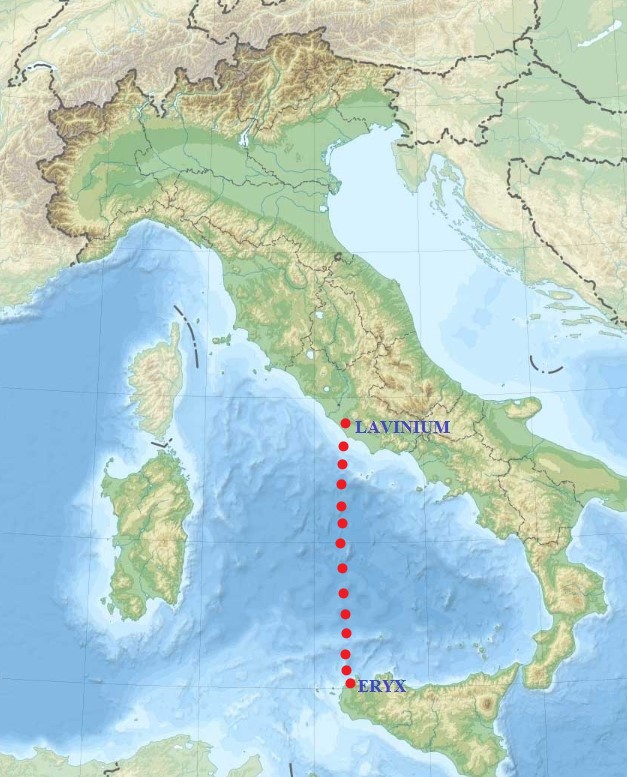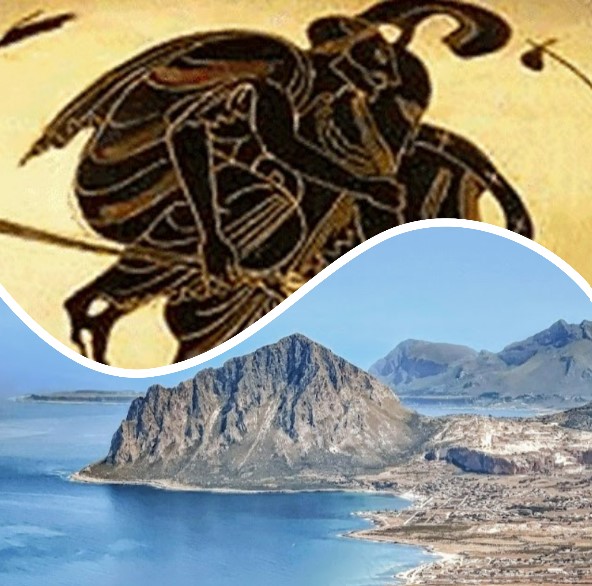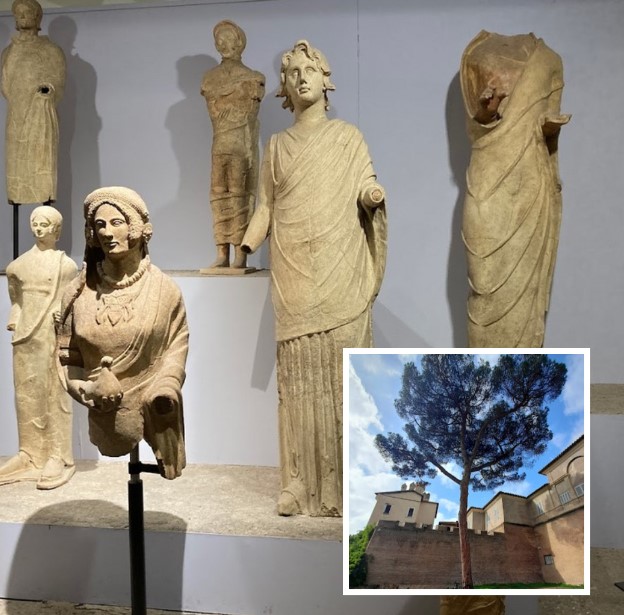The Myths of Acestes
In mythology, Acestes (or Egestes) was the son of the Sicilian river god Crimisus and a Trojan woman, Segesta (or Egesta). When Troy was attacked by the Greeks, Acestes went there to defend the city but was unable to prevent its fall. Returning to Sicily, he brought with him Elymus and three ships. It is also said that when Acestes founded the city of Segesta, he was aided by the companions of Philoctetes. According to Virgil, a legend recounts that Segesta was founded by Aeneas as a resting place for the elderly and women after they had set fire to the ships shortly before resuming their journey. Acestes’ story is narrated in various parts of Virgil’s Aeneid (notably in Book V).

Eryx and Lavinium
The Sicilian king warmly welcomed Aeneas into his kingdom and conducted funeral rites for Anchises on Mount Eryx. He later hosted Aeneas again when, after leaving Dido, Aeneas stopped at Drepanum on his way to Italy. During the funeral games held in Anchises’ honor, Acestes won the archery contest.
According to Servius, when Laomedon refused to pay Apollo and Poseidon for building the walls of Troy, the gods unleashed plagues upon the land: Poseidon ravaged it with a sea monster, while Apollo inflicted an epidemic. To rid themselves of the sea monster, the Trojans had to sacrifice noble youth to the creature. Many Trojans sent their sons away to safety. Among them was Hippotes (or Hippostratus), who entrusted his daughter Egesta to merchants who took her to Sicily. There, the river god Crimisus, in the form of a bear or a dog, married her and fathered Egestes, the founder of the city of Segesta. According to legend, Acestes hosted Aeneas and his elderly father Anchises, who died during their stay. Acestes buried Anchises with great honors on Mount Eryx (Aeneid 5.718), where funeral games were held annually in his memory. (Eryx, a mythological figure, was the son of Aphrodite and Butes and was slain by Heracles.)
Later, Acestes established colonies in Sicily with Elymus, Aeneas’ half-brother, who preferred to remain on the island. However, Virgil portrays Elymus as Acestes’ Sicilian subject.

Aeneas carrying Anchises. Attic black-figure oinochoe from Vulci, Italy (ca. 520–510 BCE) - Department of Greek, Etruscan, and Roman Antiquities of the Louvre and view of the Tyrrhenian Sea from Mount Eryx.
Dionysius of Halicarnassus calls Egestes, Aegestus, and tells another story (Roman Antiquities, Book I):
[52] When they were off Sicily, whether they had any design of landing there or were forced from their course by tempests, which are common around this sea, they landed in that part of the island which is called Drepana. Here they found the Trojans who with Elymus and Aegestus had left Troy before them and who, being favoured by both fortune and the wind, and at the same time being not overburdened with baggage, had made a quick passage to Sicily and were settled near the river Crimisus in the country of the Sicanians. For the latter had bestowed the land upon them out of friendship because of their kinship to Aegestus, who had been born and reared in Sicily owing to the following circumstance.
One of his ancestors, a distinguished man of Trojan birth, became at odds with Laomedon and the king seized him on some charge or other and put him to death, together with all his male children, lest he should suffer some mischief at their hands. But thinking it unseemly to put the man's daughters to death, as they were still maidens, and at the same time unsafe to permit them to live among the Trojans, he delivered them to some merchants, with orders to carry them as far away as possible.
They were accompanied on the voyage by a youth of distinguished family, who was in love with one of them; and he married the girl when she arrived in Sicily. And during their stay among the Sicels they had a son, named Aegestus, who learned the manners and language of the inhabitants; but after the death of his parents, Priam being then king of Troy, he obtained leave to return home. And having assisted Priam in the war against the Achaeans, he then, when the city was about to be taken, sailed back again to Sicily, being accompanied in his flight by Elymus with the three ships which Achilles had had with him when he plundered the Trojan cities and had lost when they struck on some hidden rocks.
Aeneas, meeting with the men just named, showed them great kindness and built cities for them, Aegesta and Elyma, and even left some part of his army in these towns. It is my own surmise that he did this by deliberate choice, to the end that those who were worn out by hardships or otherwise irked by the sea might enjoy rest and a safe retreat. But some writers say that the loss of part of his fleet, which was set on fire by some of the women, who were dissatisfied with their wandering, obliged him to leave behind the people who belonged to the burned ships and for that reason could sail no longer with their companions.
[53] There are many proofs of the coming of Aeneas and the Trojans to Sicily, but the most notable are the altar of Aphroditê Aeneias erected on the summit of Elymus and a temple erected to Aeneas in Aegesta; the former was built by Aeneas himself in his mother's honour, but the temple was an offering made by those of the expedition who remained behind to the memory of their deliverer. The Trojans with Elymus and Aegestus, then, remained in these parts and continued to be called Elymians; for Elymus was the first in dignity, as being of the royal family, and from him they all took their name.
But Aeneas and his companions, leaving Sicily, crossed the Tyrrhenian sea and first came to anchor in Italy in the harbour of Palinurus, which is said to have got this name from one of the pilots of Aeneas who died there. After that they put in at an island which they called Leucosia, from a woman cousin of Aeneas who died at that place.
From there they came into a deep and excellent harbour of the Opicans, and when here also one of their number died, a prominent man named Misenus, they called the harbour after him. Then, putting in by chance at the island of Prochyta and at the promontory of Caieta, they named these places in the same manner, desiring that they should serve as memorials of women who died there, one of whom is said to have been a cousin of Aeneas and the other his nurse. At last they arrived at Laurentum in Italy, where, coming to the end of their wandering, they made an entrenched camp, and the place where they encamped has from that time been called Troy. It is distant from the sea about four stades.
It was necessary for me to relate these things and to make this digression, since some historians affirm that Aeneas did not even come into Italy with the Trojans, and some that it was another Aeneas, not the son of Anchises and Aphroditê, while yet others say that it was Ascanius, Aeneas' son, and others name still other persons. And there are those who claim that Aeneas, the son of Aphroditê after he had settled his company in Italy, returned home, reigned over Troy, and dying, left his kingdom to Ascanius, his son, whose posterity possessed it for a long time. According to my conjecture these writers are deceived by mistaking the sense of Homer's verses.
For in the Iliad he represents Poseidon as foretelling the future splendour of Aeneas and his posterity on this wise:
"On great Aeneas shall devolve the reign,
And sons succeeding sons the lasting line sustain."
Thus, as they supposed that Homer knew these men reigned in Phrygia, they invented the return of Aeneas, as if it were not possible for them to reign over Trojans while living in Italy. But it was not impossible for Aeneas to reign over the Trojans he had taken with him, even though they were settled in another country. However, other reasons also might be given for this error.
The account by Dionysius appears to be a rationalized interpretation of the original legend.
According to Lycophron, Egesta was the daughter of Phenodamas, a Trojan who advised his compatriots to sacrifice Laomedon’s daughter Hesione to the sea monster. In revenge, Laomedon handed over Phenodamas’ three daughters to sailors, instructing them to leave the girls in Sicily as prey for wild beasts. The three young women escaped death with the help of Aphrodite. One of them, Egesta, married the river god Crimisus. Their son, Acestes, founded the cities of Segesta, Eryx, and Entella.
A tradition holds that Egesta, daughter of Hippotes, returned from Sicily to Troy, where she married Capys and bore Anchises.

Borghese Castle and terracotta votive statues found at the sanctuary of Lavinium, exhibited in the nearby Archaeological Museum of Lavinium (Pomezia), Italy
Another figure named Egestes is mentioned in Roman mythology as a priest in Lavinium, a city founded by Aeneas to house the Penates brought from Troy.
Aeneas, following Hector’s advice, took Troy’s Penates with him. These household gods appeared to him in a dream, guiding his route to the shores of Italy (Aeneid 3.148). Aeneas offered sacrifices to them according to Roman domestic rituals (Aeneid 5.62) and, upon sighting Italy, solemnly thanked and invoked them: O faithful Penates of Troy, hail!
(Aeneid 7.121). He established their worship in Lavinium: The town first founded in Latium of the Roman race, Lavinium; for there are our Penates
(Varro, De Lingua Latina, 5.144).
Indeed, Lavinium housed a famous sanctuary dedicated to the Penates, which high-ranking magistrates visited upon assuming office. The prominence of the Penates of Lavinium overshadowed that of the Penates of Alba Longa, even though Alba was the mother city of the Latin confederation. Legend held that after the destruction of Alba, the Penates were transferred to Rome. To reinforce the importance of the Lavinian Penates, a Trojan legend claimed that when Ascanius founded Alba Longa, he moved the Penates from Lavinium to Alba, but they twice returned mysteriously to Lavinium during the night (Dionysius of Halicarnassus, 1.67). Since the Penates were always found in Lavinium, Egestes, followed by 600 family heads, traveled from Alba to Lanuvium to ensure the Penates’ worship in their chosen resting place.
The cult of the Penates was a Latin tradition, not exclusively Roman. The Penates were venerated alongside the cult of Vesta in Latium, particularly in Lavinium, Alba Longa, and Praeneste. The connection made by historians and theologians between the legend of Aeneas and the origins of the Roman people also linked the history of the Penates of these cities. From Troy to Lavinium, Alba Longa, and finally Rome, the Penates symbolized the continuity of Aeneas’ lineage and the fulfillment of Ilium’s destiny in Rome.
Today, the ancient Lavinium has disappeared. The medieval village of Pratica di Mare (Pomezia), dominated by the Borghese Castle, now stands where its acropolis once rose, while the ancient city’s walls, temples, and buildings lie buried beneath cultivated fields.
Last update: December 1, 2024
Go to definitions: A | B | C | D | E | F | G | H | I | J | K | L | M | N | O | P | Q | R | S | T | U | V | W | X | Y | Z
 DONATE
DONATE 
See also: